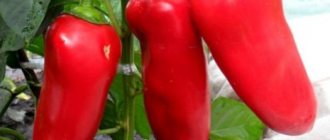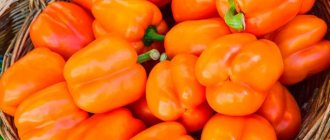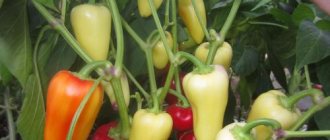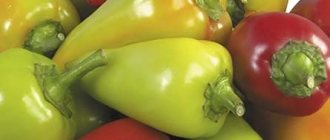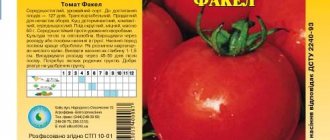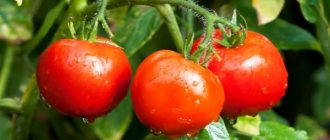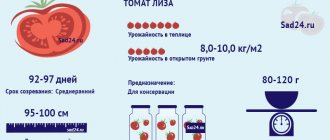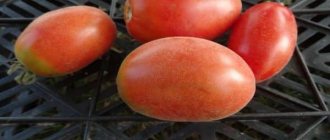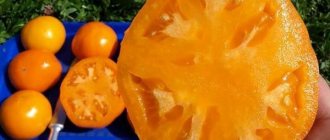Many people love sweet aromatic peppers, both fresh and in various dishes, because they add an unsurpassed taste to culinary masterpieces.
In addition, it also contains many vitamins and microelements that are beneficial for the body, and is indicated even during dietary nutrition. But not everyone knows how to grow it on their own plot, but it tastes much better from your own garden.
Description of the variety
The pepper variety “Butuz” belongs to the mid-early varieties; the first harvest ripens 120-130 after germination. It is included in the state register of the Russian Federation as suitable for planting in open soil and in greenhouse conditions. This means that it can be grown even in regions with harsh climates. In addition to Russia, it is planted in Ukraine and Moldova.
It is a high-yielding variety; from 1 m2 you can harvest approximately 6-7 kg of pepper; in greenhouse conditions these figures increase. It has spreading bushes, the height of which reaches 0.7-0.8 m, the stem is powerful, abundantly covered with leaves of standard size, they are dark green in color.
The fruits are cylindrical in shape, at the stage of technical maturity, light green in color; at this time they can be collected and eaten, or stored until fully ripe. This is a huge plus if the pepper is grown for sale, because in this case the shelf life increases. When biological maturity occurs, it turns bright red. On average, the weight of the fruit ranges from 150 to 200 grams, the walls of the pepper are 0.7-0.8 cm thick. The flesh is fleshy, crispy and very juicy and has high taste.
Butuz pepper can be eaten fresh, added to salads, and in various dishes. After heat treatment, its taste and beneficial properties do not deteriorate. It is suitable for freezing for the winter and preparing various preserves.
Like any variety, “Butuz” has its pros and cons:
Description of Butuz pepper, reviews, photos
A medium-early, medium-sized variety of sweet pepper for all types of greenhouses.
The period from germination to the beginning of ripening is 115-130 days. The bush is semi-spreading, 70-80 cm high. The leaf is medium size, dark green. Formation of the plant consists of removing all side shoots up to the first fork.
Sweet pepper Butuz is included in the State Register of the Russian Federation.
Fruit characteristics
The fruits are drooping, cone-shaped, glossy, greenish-white at the stage of technical ripeness, red at the biological stage, weighing 180-200 grams, juicy, good taste. Wall thickness is about 7 mm. This pepper is recommended for fresh use, home cooking and canning.
Marketable yield : 6.1 kg of fruits per 1 sq. meters of landings.
The variety is resistant to major pepper diseases.
Growing and care
Planting seedlings
This variety is sown for seedlings already in February; for this you will need containers or cups with a volume of 200 ml.
You can purchase soil at a gardening store or make it yourself from soil from the site, peat, sand, turf soil and humus. This mixture must be disinfected by spraying with a weak solution of fungicides or calcined in an oven at a temperature of 1000 C. Important! When processing in the oven, the temperature should not be higher than 100 degrees, this can destroy all the beneficial substances.
If seeds are collected from last year's harvest, they must be tested for germination. To do this, they are placed in a 5% aqueous solution of salt and waited for 5 minutes, those that floated are empty, and those that sank are good. Having selected viable seeds, they are pickled in manganese. Place it in the prepared solution in a bag made of gauze for 20 minutes. After this, the seeds should be washed and dried. In order for seedlings to appear faster, the seeds are left in a growth stimulator for 12 hours.
When planting seeds for seedlings, the depth of the hole should not exceed 2 cm, otherwise the first shoots will not appear soon. After planting the seeds in the soil, watering is required; for this, warm, settled water is used. Then the container with them is covered with film to create a greenhouse effect. The optimal room temperature is considered to be 25-28 degrees. After the seedlings hatch, the film is removed. Daylight for seedlings should be at least 12 hours, so when it gets dark outside, turn on a pre-installed fluorescent lamp.
The soil must be loosened periodically, for example, using a plastic fork. For the first 14 days, seedlings need daily watering, but not abundantly. Then it is recommended to feed the young seedlings; for this you can use mineral fertilizers. If the seeds are planted in a common container, picking is necessary when two true leaves appear. This must be done carefully so as not to damage the fragile plant.
Bedding
“Butuz” is transferred to the greenhouse in early May, and to open soil in early June. The holes are dug at a distance of 40 cm, while the gap between the rows should be at least 60 cm. Before planting the seedlings, humus is added to the holes and watered with warm water. Also, pegs are dug in along with the seedlings in order to tie up peppers in the future.
During the season, the bushes are fertilized 2-3 times, with mineral fertilizers or organic matter. Be sure to water 1-2 times a week, but do not moisten the soil too much.
Technology for growing Butuz pepper
It is possible to achieve good yields of Butuz pepper only if you follow the rules for its cultivation, although in general the variety is considered unpretentious. Among the important stages of agricultural technology for this variety: correct selection and preparation of the planting site, preparation of soil mixture for seedlings, processing of seeds for planting, caring for seedlings and planting them in the ground.
Selection and preparation of a site
In agronomy, there is such a thing as crop rotation - the correct alternation of growing crops on one plot of land, which allows you to preserve useful soil resources and clear them of diseases of certain crops. When growing peppers, be sure to follow the rules of crop rotation.
Thus, Butuz pepper will grow well after crops such as cucumbers, cabbage and salads, greens, legumes, rapeseed, alfalfa and other green manures. At the same time, it is not recommended to grow peppers for two or three years in a row in one place, or after nightshades: potatoes, tomatoes, eggplants.
Interesting! A crop such as oats cleanses the soil of pathogens of many diseases, and the roots of legumes are inhabited by bacteria that naturally accumulate nitrogen in the soil.
Also, when choosing a site, you need to take into account its microclimate: the site should be well-lit, ventilated, other nightshades and, especially, other varieties of sweet peppers or even hot peppers should not be planted next to the pepper site. They will pollinate each other, reducing the varietal quality of the pepper.
The site must be prepared in the fall by generously applying organic fertilizers. Deep plowing of the soil in the winter is required, thanks to which fertilizers will be better absorbed by the soil, and the soil as a whole will freeze, which will destroy most pests and pathogens.
Preparing the substrate for seedlings
Ordinary soil taken from the garden will not be able to produce extra-high-quality seedlings, so it is necessary to prepare a loose and fertile substrate on its basis. In equal parts, ordinary soil is mixed with peat, humus, sand and turf soil (or sawdust).
The resulting mixture must be disinfected by spraying with a weak solution of potassium permanganate or fungicides. The substrate can also be kept in the cold for a month, but in this case you need to prepare it in advance. Heat treatment also works well: calcination in the oven or steaming in a water bath for about 40-50 minutes at temperatures up to 100 ºС.
Important! The soil treatment temperature should in no case exceed 100 ºС, otherwise all nutrients will be destroyed and the mixture will become useless.
Pre-sowing preparation of seeds and their planting for seedlings
Collected seeds must undergo a calibration procedure, i.e. selection. To do this, prepare an aqueous solution of salt at a concentration of 5%. The seeds are poured into a container with the solution and left there for up to 5 minutes. During this time, empty seeds will float to the surface, and good seeds, on the contrary, will sink to the bottom.
Like the soil, the seeds should be treated with a solution of potassium permanganate or fungicide. To do this, the seeds are dipped into the prepared solution in a gauze bag for 20 minutes, then washed with warm water and dried.
In order for healthy and powerful seedlings to appear quickly, the seeds need to be treated with growth stimulants, for example, Ideal, Epin-Extra, Kornevin. They can be replaced with a solution of 1 tbsp. spoons of ash per liter of water. Seeds are left in such nutrient solutions for up to 5-6 hours.
A week before planting, the seeds are hardened by leaving them in the refrigerator - first for half an hour, gradually increasing the time every day. After refrigeration, the seeds must be placed in a warm room.
Important! When hardening seeds, they must be dry.
Germination can be used as the final stage of seed preparation, although not everyone does this. To do this, 3-4 days before planting, the seeds are placed on a damp cloth and kept until sprouts appear. The seeds that are wired are guaranteed to germinate much faster.
Butuz pepper seeds are planted for seedlings in late February - early March. The container for planting must have a drainage hole in the bottom, must be washed well with soapy water and disinfected with a solution of potassium permanganate or fungicide.
Pepper seeds are planted in the soil to a depth of no more than 2 cm. The soil should be watered with warm water. The container with the planted seeds is covered with glass or film. Optimal temperature for seedlings: +26ºС - +28ºС. To speed up germination and further growth of seedlings, fluorescent lamps are installed around the perimeter of the boxes with seedlings, which are turned on when it gets dark.
Important! When shoots appear, the film is removed from the seedlings, otherwise the seedlings will quickly stretch out and be thin.
Two weeks after planting pepper seeds, it is necessary to fertilize with complex mineral fertilizers. Before planting seedlings in the ground or greenhouse, the soil in the pots must be carefully loosened and moistened in a timely manner. Seedlings are picked in the phase of appearance of two true leaves.
Planting seedlings in open ground and further care
At the end of May and beginning of June, Butuz pepper seedlings are planted in open ground or a greenhouse. Planting pattern: 60 cm between rows and 40 cm between bushes in a row. Pepper does not develop lateral roots from the stem, so it is not recommended to deepen the seedlings too deeply into the ground. The holes should be fertilized with humus and spilled with warm water.
Simultaneously with planting seedlings, you can immediately dig wooden pegs into the ground for future gartering of bushes. It is recommended to mulch the soil around the bushes with sawdust. When the bushes grow 40-50 cm, they begin to be tied up. During the growing season, it is useful to carry out 2-3 feedings, adding solutions of mineral or organic fertilizers to the root of the bushes. Watering should be carried out 1-2 times a week, depending on climatic conditions. You should also not over-water it, as there is a risk of disease.
Resistance to diseases and weather conditions
This variety tolerates deteriorating weather conditions well, but in any case this will affect the harvest.
It is resistant to many common diseases, but for prevention it is better to treat it with fungicides several times, at ten-day intervals. The first treatment should be carried out 14 days after planting in a permanent place. Insecticides are used to prevent pests.
Advantages and disadvantages
The obvious advantages of this variety are:
- Mid-early period of full ripening.
- The fruits are characterized by their bright color and glossy surface.
- Excellent gastronomic qualities, allowing the vegetable to be used in cooking.
- Disease resistance.
Despite the large list of advantages, this variety of sweet pepper does not have high yields. In addition, wide shrubs require obligatory tying to a support.
Reviews
Yaroslava 55 years old Ufa
In our family, everyone just loves sweet peppers, so we plant a lot of them. We grow it in a greenhouse, and this year we tried a new variety, “Butuz”. I was pleased that not a single bush got sick, since they didn’t treat it with anything at all, even for prevention. The harvest was good, and we ate it ourselves and passed it on to the children, plus we froze it for the winter; I really like adding pepper to first courses. I also preserved several salads and slices in brine. I was pleased and will definitely plant more next year.
Anatoly 63 years old
I have been planting “Butuz” for several years now, during which time the plants have never gotten sick. Of course, I carry out prevention, but, as you know, it does not always save. I grow the seedlings myself, they turn out strong and healthy. The fruits are large, have excellent taste, my wife perfectly covers whole peppers for the winter, I’m ready to sell my soul for it. Yes, I really like stuffed ones, and this variety makes them very tasty.
https://youtu.be/5MQd3cQvNjY
Rules of agricultural technology
Even the highest quality seed material and the best fertile soil do not guarantee a high yield without due attention to theoretical issues based on many years of research by breeders and those who have experience in growing Butuz pepper. Preparing seeds and growing seedlings is the most significant stage.
Germinating seeds for seedlings
In the southern regions, with a predominant subtropical climate, Butuz pepper is planted in the ground in the middle or end of May, when the threat of late frosts has passed. It is preferable to plant already strong and healthy seedlings in the ground - they will take root better in the soil, and the plants will quickly grow.
To achieve the best results, you need to follow a few simple rules for preparing seeds before sowing seedlings.
- Before sowing, check the seeds for germination.
- Seed disinfection must be carried out if untested planting material is used.
- Prepare the soil substrate.
If the seeds are purchased from manufacturers, then the disinfection stage can be skipped, and for greater effect, the seeds can be soaked using biogrowth stimulants. Seeds personally selected from the best, largest and most ripe fruits must be treated with a weak manganese solution.
Attention! Soaking and germination allows you to check seeds for germination and avoid wasting time and materials while waiting for germination.
The choice of containers for seedlings plays an important role in growing vegetables. The best option for sowing germinated seeds is peat pots. The cost of purchasing peat pots will pay off when you transplant peppers into the ground, since, in addition to protecting the root system from damage, they serve as an additional fertilizer for the plants.
The mixture for seedlings consists of humus, turf and peat, in equal parts. But, if it is planted in peat pots, then there are only two elements left to add.
Landing
Healthy and strong seedlings will not create big problems when growing Butuz pepper and will be the key to a good harvest. Seedlings are planted in the ground at the age of 70 days, and approximately 60 days remain until the end of the growing season, which will require especially careful care.
Choose the brightest area for your peppers so that the plants receive the maximum amount of light during flowering and fruit ripening. But keep in mind that too hot sun rays can cause burns. You can plant the plants in an area near trees that will provide a little shade, protecting the pepper from the direct rays of the sun.
Care
To protect the root system from drying out, mulch the soil, especially on the hottest days. Watering should be done in the morning, and fertilizing should be done in the evening. After watering, be sure to loosen the soil. Fruit ovaries on plants form until the beginning of August, but in mid-July the flowers need to be picked off to allow the fully formed fruits to ripen.
As they ripen, cut the fruits with pruning shears, being careful not to damage the plant, which continues to bear fruit.
Characteristics and cultivation features
Butuz is one of the mid-early varieties. 130 days after germination, fruits appear on it. The bush is tall, up to 80 cm in height, the dark green leaves are not large, but cover the bush abundantly. Pepper is a heat-loving crop, so the best place for it is greenhouses.
Pepper seedlings are sown in February using containers or plastic cups; seedlings appear on the 6th day. Having seen two real leaves, the gardener should know that it’s time to pick the seedlings. It is not recommended to do this before; the plants may get sick.
In the last ten days of May, the peppers are transplanted into a greenhouse; the soil temperature should be no lower than 13C. The distance between the bushes should be 40x60 cm.
Pepper loves light and warmth, which is why it is better to grow pepper in greenhouse conditions; there are no other preferences. Basically, the crop is not picky, but the harvest in open ground will be a little poorer, even if you make every effort. At the beginning of summer, it is not uncommon for the air temperature to drop during the day and especially at night; there may be cold rains with gusty winds. All these unfavorable weather factors do not have the best effect on the growth of the bush and the formation of fruits, so closed ground is considered the best option. Butuz is a high-yielding variety. From one square meter you can get up to 6 kg of pepper. The variety is disease resistant.
Loosening the soil and watering should be done regularly, this promotes active growth and formation of fruits. There is no need to form a bush, but it is recommended to cut off the leaves up to the lower fork. Experienced gardeners advise tying up the branches of the bush, otherwise they may break off. In addition to watering and loosening the soil, caring for the plant includes fertilizing; it is done twice:
- the first time - two weeks after you finish picking the seedlings;
- the second time - two weeks after the first feeding.
The fruits of the Butuz variety will turn from green before your eyes to bright red, which will demonstrate their ripeness and readiness for harvesting. The weight of one cone-shaped fruit is 160-2000 g, which is not a bad indicator. Also very popular is the California Miracle variety.
Peppers are consumed fresh, stuffed, added to stews, sauces, first courses, made into lecho, winter preparations or frozen. Dishes made with them are aromatic, tasty and healthy.
Growing the Butuz variety
Despite the ease of care, good yields are possible if all growing rules are followed. One of the main stages of planting and care techniques is high-quality preparation of the site. You also need to be responsible in preparing the soil for seedlings, processing the seeds and caring for the sprouts before transplanting into the ground.
For stable growth of the Butuz sweet pepper fruits, you need to strictly adhere to the rules of crop rotation. The shrub will develop well in soil where cucumbers, lettuce, herbs or cabbage previously grew. But it is strictly not recommended to plant them in the soil after potatoes or tomatoes.
Also, when choosing a landing site, you must comply with the following conditions:
- The site must receive sufficient sunlight.
- The place where the vegetable grows must be well ventilated.
- Other types should not be planted near one variety, especially bitter or hot peppers.
- Preliminary preparation of the site includes the mandatory application of fertilizers in the autumn.
- Before the onset of winter, you should dig deep into the area for sowing. This method allows you to destroy the bulk of harmful bacteria and microorganisms.
Storage and transportation rules
If you pick peppers at the stage of technical ripeness, the fruits are stored in a cool, shady place for about a month. Ripe pods can be stored in the refrigerator for 2 weeks. Peppers can be frozen and canned. The variety is well transported over long distances and at the same time retains its presentation.
Stepan Arkadievich, Sochi
Pepper “Butuz” has neat fruits, so it has occupied a worthy place in my plot for several years now. It is unpretentious in care, the main thing is to tie up the bushes. Ripe peppers are sweet and juicy. Goes well in salads. Ideal for stuffing.
Marina, Moscow.
I grow Butuz pepper on my plot. I use it not only for personal purposes, but also sell it. It looks attractive and does not crack during transportation. It's always a good buy. I noted for myself its excellent taste, ideal for preservation.
Read also: Raspberry miracle tomatoes: variety description, growing tips
Nikita, Perm
I grow Butuz pepper in a greenhouse. I tried to plant in open ground, but it gave a very poor harvest, now I don’t risk it. When caring, you need to water and tie it up on time. I like that it is resistant to various diseases.
